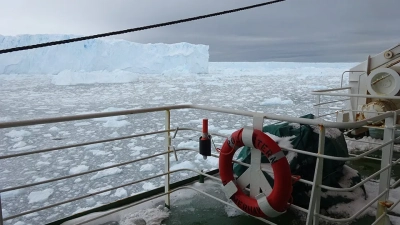- Home
- Our Offers
- Media
- News
- Newsflashes
- Flusssystem
MARUM-MeBo in the Antarctic
The team examined sediment samples that were collected during the PS104 expedition of the research icebreaker POLARSTERN in February/March 2017 with the MARUM-MeBo 70 drill rig in the Amundsen Sea off the West Antarctic coast. Sedimentological, petrological, geochronological and thermochronological analyses show that most of the minerals and rock fragments in these samples do not originate from West Antarctica, but can be assigned to the Transantarctic Mountains on the edge of East Antarctica, thousands of kilometers away. Since the late Eocene, this mountain range has risen as a steep shoulder of a continental rift, the Antarctic Rift System, which today divides Antarctica into the two land masses of East and West Antarctica.
Uplift and erosion of the Transantarctic Mountains have since produced large amounts of erosion debris, which the newly discovered stream transported over a distance of more than 1,500 kilometers through the West Antarctic Rift System into today's Amundsen Sea, where it was deposited in a swampy river delta. This was confirmed by analyzing seismic data. Modern examples of large river systems in a similar geological environment are the Nile in the East African Rift Valley or the Rhine in the Upper Rhine Graben.
The existence of such a transcontinental river system shows that - unlike today - large parts of West Antarctica must have been extended flat coastal plains above sea level. Due to the low topography, West Antarctica was still ice-free at the end of the Eocene, while the mountainous regions of East Antarctica were already beginning to freeze over.
Maximilian Zundel, Cornelia Spiegel, Chris Mark, Ian Millar, David Chew, Johann Klages, Karsten Gohl, Claus-Dieter Hillenbrand, Yani Najman, Ulrich Salzmann, Werner Ehrmann, Jürgen Titschack, Thorsten Bauersachs, Gabriele Uenzelmann-Neben, Torsten Bickert, Juliane Müller, Rober Larter, Frank Lisker, Steve Bohaty, Gerhard Kuhn, the Science Team of Expedition PS104: A large-scale transcontinental river system crossed West Antarctica during the Eocene. Science Advances 2024. DOI: 10.1126/sciadv.adn6056



